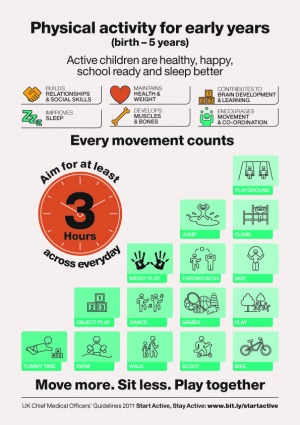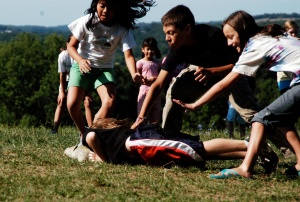Physical Activity in Young People
Original Editor - Michelle Warren
Top Contributors - Wendy Walker, Shaimaa Eldib, Blaithin Hadjisophocleous, Kim Jackson, Lucinda hampton, Mariam Hashem, Tarina van der Stockt, Simisola Ajeyalemi, Admin, Oyemi Sillo, Michelle Lee and Rucha Gadgil
Introduction[edit | edit source]
It is well understood that physical activity (PA) can provide many health benefits to those who partake, and that physical inactivity can have detrimental outcomes on our health. Questions still abound about what qualifies as suitable physical activity, and how much should each child do? Sometimes we have good intentions, but find barriers.
Definitions[edit | edit source]
- Physical activity: any bodily movement produced by skeletal muscles that requires energy expenditure.
- Infant: newborn to 1 year old child[1]
- Toddler: 1-2 years old child
- Preschooler: 3-4 years old child
- Adolescent: 12-17 years old child
- Adult: 18+ years old.
- Physical literacy: is the mastering of fundamental movement skills and fundamental sport skills that permit a child to read their environment and make appropriate decisions, allowing them to move confidently and with control in a wide range of physical activity situations[2].
Physical Literacy[edit | edit source]
Having increased physical literacy helps us to stay more physically active throughout life. Setting the tone for our children when they are young helps to establish good physical literacy. To be physically literate, you must be able to do the following: dodge, kick, run, jump, hop, log roll, dribble, stand on one foot, sidearm strike, and overhand throw[3].
Benefits of PA[edit | edit source]
Physical activity can provide both immediate and long-term health benefits, physically, mentally and socially. It can also foster independence and help with learning[4].
Some immediate benefits of exercise include: enhanced mood, aid in self-regulation, reduction of blood sugar levels and feeling of well-being.
Many long-term benefits are observable as well. Moderate impact cardiovascular activities can benefit school-aged children and adolescents by decreasing the risks of Type 2 Diabetes, stroke, heart disease, blood pressure, adiposity levels, anxiety, and depression[5]. Exercise also helps to increase a child’s self-confidence, strength, physical literacy[5], cardiovascular fitness, and flexibility. High-impact activities can increase (or help to maintain) bone density[5]. Furthermore, studies have shown that children who participate in regular physical activity are less likely to use tobacco, alcohol and drugs and are better able to maintain a healthy body weight[5].
Physical inactivity has been identified as the fourth leading risk factor for global mortality causing an estimated 3.2 million deaths globally[1]. It has a detrimental impact on mental and physical health, and is preventable.
A sedentary lifestyle, and use of excessive television viewing and computer games can also lead to poor sleep quality, which then also has an impact on cognition and memory[6].
The Active Healthy Kids Global Alliance has created report cards with respect to physical activity and inactivity.
The average grade in the 38 countries included is only “poor” or “D” grade, however the supports required are a “c” grade globally. Interestingly, countries with lower-income seem to score better grades for activity than higher income countries[7].
How Much PA is Recommended?[edit | edit source]
- Babies should be physically active several times daily – particularly through interactive floor-based play. Limit “container” activities such as standers and jumper type containers.
- Toddlers (aged 1–2 years) and preschoolers (aged 3–4 years) should accumulate at least 180 minutes of physical activity at any intensity spread throughout the day[8], including: A variety of activities in different environments; Activities that develop movement skills; Progression toward at least 60 minutes of energetic play by 5 years of age.
- The American Heart Association recommends that all children age 2 and older participate in a minimum of 60 minutes of enjoyable moderate-intensity physical activities every day[9].
- According to the Australian Physical Activity Guidelines, a child under 6 years of age should not be sedentary, restrained, or kept inactive for more than 60 minutes at a time, with the exception of sleeping[10].
- The World Health Organization (WHO) recommends that children aged 5 and older accumulate at least 60 minutes of moderate to vigorous intensity activity daily, with additional benefits for even more time[11]. Their activities should include bone and muscle strengthening at least 3 times per week[11].
The UK's Department of Health and Social Care has published the following infographics for babies, toddlers and children, with guidelines and explanations of physical activity in the different age groups:


Risks[edit | edit source]
Musculoskeletal injury and concussions are the biggest risks associated with participating in sport and recreation activities. According to the Canadian Paediatric Society, many of these injuries are preventable. The incidence is higher in boys than it is in girls[14]. Children are more vulnerable to injury than are adults as a result of their physical and physiological differences. In many countries, programs and policies have been implemented to try to reduce the risk of injuries from impact, falls and drownings.
Recent research is now showing that children under 12 years of age that participate predominantly in one sport are at greater risk of injury[15]. A child’s physical literacy is also improved if they are engaged in a variety of sports and physical activities. Exposure to abuse, bullying and violence by coaches, peers and parents is a potential risk too[16]. Children in certain populations or with certain disorders/medical conditions are at higher risk of injury with sport participation. These include children with ADHD and DCD[17].
Resources[edit | edit source]
Ideas & recommendations for increasing PA can be found on the following websites:
- Centers for Disease Control and Prevention
- World Health Organisation
- Canadian Pediatric Society
- Government of Canada (children and PA)
- International Physical Literacy Society
- Want Smarter, Healthier Kids? Try Physical Education! | Paul Zientarski | TEDxBend
References[edit | edit source]
- ↑ 1.0 1.1 World Health Organization. Physical activity [internet]. 2017. [cited 2/1/18]. Available from: http://www.who.int/topics/physical_activity/en/
- ↑ Pacific Institute for Sport excellence. What is physical literacy? [Internet]. 2017. [cited 2/1/18]. Available from: http://www.pise.ca/physical-literacy/
- ↑ Hardy LL, King L, Farrell L, Macniven R, Howlett S. Fundamental movement skills among Australian preschool children. Journal of Science and Medicine in Sport. 2010 Sep 1;13(5):503-8.
- ↑ Strong WB, Malina RM, Blimkie CJ, Daniels SR, Dishman RK, Gutin B, Hergenroeder AC, Must A, Nixon PA, Pivarnik JM, Rowland T, Trost S, Trudeau F: Evidence based physical activity for school-age youth. J Pediatr. 2005, 146 (6): 732-737. 10.1016/j.jpeds.2005.01.055.
- ↑ 5.0 5.1 5.2 5.3 Janssen I, LeBlanc AG. Systematic review of the health benefits of physical activity and fitness in school-aged children and youth. International journal of behavioral nutrition and physical activity. 2010 Dec;7(1):40.
- ↑ Dworak M, Schierl T, Bruns T, Strüder HK. Impact of singular excessive computer game and television exposure on sleep patterns and memory performance of school-aged children. Pediatrics. 2007 Nov 1;120(5):978-85.
- ↑ Active Healthy Kids Global Alliance. The Global Matrix 3.0 on physical activity for children and youth. https://www.activehealthykids.org/ [accessed 15 Oct 2018]
- ↑ Tucker P. The physical activity levels of preschool-aged children: A systematic review. Early Childhood Research Quarterly. 2008 Oct 1;23(4):547-58.
- ↑ Pate RR, Davis MG, Robinson TN, Stone EJ, McKenzie TL, Young JC. Promoting physical activity in children and youth: a leadership role for schools: a scientific statement from the American Heart Association Council on Nutrition, Physical Activity, and Metabolism (Physical Activity Committee) in collaboration with the Councils on Cardiovascular Disease in the Young and Cardiovascular Nursing. Circulation. 2006 Sep 12;114(11):1214-24.
- ↑ Australian Governement Department of Health. Australia's Physical Activity and Sedentary Behaviour Guidelineshttp://www.health.gov.au/internet/main/publishing.nsf/content/health-pubhlth-strateg-phys-act-guidelines
- ↑ 11.0 11.1 World Health Organization. Physical activity and young peoplehttp://www.who.int/dietphysicalactivity/factsheet_young_people/en/
- ↑ GOV.UK.Start active, stay active: infographics on physical activityhttps://www.gov.uk/government/publications/start-active-stay-active-infographics-on-physical-activity
- ↑ GOV.UK.Start active, stay active: infographics on physical activityhttps://www.gov.uk/government/publications/start-active-stay-active-infographics-on-physical-activity
- ↑ Morrongiello BA, Dawber T. Mothers' responses to sons and daughters engaging in injury-risk behaviors on a playground: Implications for sex differences in injury rates. Journal of experimental child psychology. 2000 Jun 30;76(2):89-103.
- ↑ Dallas M E. Injury risk may rise when kids play just one sport [internet]. HealthDay. 2017. [cited 2/1/18]. Available from: https://consumer.healthday.com/fitness-information-14/sports-medicine-news-634/injury-risk-may-rise-when-kids-play-just-one-sport-720634.html
- ↑ Mountjoy M, Rhind DJ, Tiivas A, Leglise M. Safeguarding the child athlete in sport: a review, a framework and recommendations for the IOC youth athlete development model. Br J Sports Med. 2015 Jul 1;49(13):883-6.
- ↑ Tan B, Carnduff R, McKay C, Kang J, Romiti M, Nasuti G, Hurtubise K, Jarus T, Boyd L, Doyle-Baker P, Wilson B. Risk factors for sport injury in elementary school children: are children with developmental coordination disorder or attention deficit hyperactivity disorder at greater risk of injury?. Br J Sports Med. 2014 Apr 1;48(7):663-4.
- ↑ PRB:Youth and NCDs Available from: https://www.youtube.com/watch?v=rrqhDiqCPKQ







